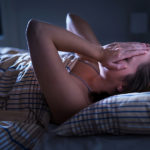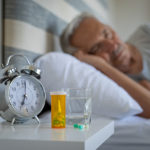By David Blyweiss, M.D., Advanced Natural Wellness
December 10, 2021
A lot of people tend to think snoring and sleep apnea are the same thing. They aren’t.
When you snore, the soft tissue in your neck relaxes and vibrates when you draw in air. That vibration is the noise of snoring.
Not everyone who snores has sleep apnea. But most people with sleep apnea do tend to snore.
The difference is going to be in how you feel when you wake up in the morning. Normal snoring generally doesn’t disturb your sleep too much, so you should generally wake up feeling pretty refreshed.
With sleep apnea, you can’t get enough air because your airflow is obstructed. So breathing stops and starts repeatedly throughout the night. You might stop breathing for several seconds at a time. This can leave you feeling fatigued, moody, exhausted and unable to concentrate during the day.
Even worse, sleep apnea is strongly linked to heart disease, heart failure, stroke, atrial fibrillation, type 2 diabetes, inflammation and early death.
It also places you at a higher risk of Alzheimer’s disease. While you sleep, cerebral spinal fluid flushes out all the damaging debris and oxidative stress (via the glymphatic system) that accumulated in the brain during the day. Sleep apnea reduces glymphatic clearance so all the “junk” doesn’t get cleared out. It just keeps accumulating.
MD Exposes the Hidden Danger to Your Eyes

When your eyesight starts to fail, it's a real problem. Suddenly you can't go to the grocery store... you can't get to the doctor if you have an emergency... you can't meet your friends for dinner…
Your "regular" doctor doesn't have time to keep up with the latest research. And the same goes for eye doctors. They go to school to learn how to fit you for glasses and contacts, but have no way of preventing the damage and loss of eyesight that threatens your freedom and independence.
Let me show you something that explains a LOT about how your eyes work.
In my FREE Special Report, I'll show you a HUGE, untapped resource for your eyes that safely and naturally restores clear, effortless eyesight.
Click here to get started...
So if your spouse or someone says “geez, you’re really snoring bad,” you want to consider getting checked out. If you’re on your own, you can look for symptoms like waking up snorting or gasping, or feeling fatigued, headachy, dry-mouthed, irritable and scatter-brained in the morning. If you’ve had multiple heart attacks or are carrying extra weight, that makes it even more important to get tested.
Taking an At-Home Sleep Apnea Test is Easy
If you think you have sleep apnea, you can start out with a home test. It’s a Velcro belt that goes around your chest, a pulse oximeter and a small nasal cannula with an oxygen concentrator. All it really does is track oxygen levels and your breathing; how much effort it takes to breathe, whether your breathing is shallow and any pauses or absence of breathing.
If the at-home test indicates apnea, an overnight sleep test at the hospital or a sleep clinic might be recommended. This will capture a lot more data to better diagnose your condition. And don’t worry, if you can’t sleep when you’re not at home, they’ll give you a sedative to help you sleep long enough to obtain the data they need.
Chances are good that, if you’re diagnosed with sleep apnea, you’ll be sent home with a CPAP machine. It’s the gold standard treatment for obstructive sleep apnea.
But these days a lot of people are looking into those implants that stimulate your upper airway. They don’t like the idea of wearing a mask while sleeping, and these implants sound like a great alternative.
Sleep apnea implants – known as hypoglossal nerve stimulators – haven’t been on the market for that long.
But I’ll tell you the same thing I shared with a friend of mine. He was told he needed to have a new device they could implant into his esophagus to keep his gastroesophageal reflux from bothering him. He was worried about all the things that could go wrong… death, infection, internal bleeding and so on.
I told him about some things he could do on his own to get rid of the reflux, and guess what happened? He did all of those things and stopped having reflux. And he didn’t have to get an implantable device.
When it comes to the apnea implants, the list of potential side effects is crazy. On the serious side are excessive bleeding, infection, nerve trauma, air or fluid buildup around the lung, choking, rejection of the implant and persistent pain or numbness at the implant site.
Are You Suffering From...
- Love handles and a pot belly
- Romance that isn't what it used to
- Forgetfulness and inattention
- Low (or no) strength and endurance
- A sex drive that's shifted into neutral...or worse
If so...you may have Mature Male Burnout. Click here to discover more about this unique condition and what you can do about it.
On the extremely annoying side are tongue soreness, difficulties swallowing or speaking, persistent coughing and insomnia.
And it’s not like you can clear your throat or cough to get rid of the thing if you don’t like it. It’s implanted in your body. And if it has too much scar tissue around it, it can be difficult to remove without damaging the entire area.
So I still recommend the CPAP. And now they have little nasal pillow plugs so you don’t have to put a mask on your face. They are great for light sleepers and people who find the regular masks bulky. So that removes a lot of the CPAP mask objections, and it could save your life.
In the meantime, the best thing you can do is take charge.
Get Your Breathing Under Control
There are certain things that can cause or contribute to sleep apnea. If you can get them under control, you can start breathing easier.
Lose weight. Sleep apnea patients who drop excess pounds often see huge improvements in their symptoms. I recently wrote a three-part series on what’s causing America’s weight gain, and what you can do about it.
Stay active. People with more sedentary behavior – like a sedentary job or sitting around watching TV – are at much greater risk of developing sleep apnea. So get moving! Talk a walk every day, ride a bike. Whatever works best for you.
Avoid alcohol prior to bedtime. Alcohol relaxes the throat muscles involved in snoring and sleep apnea. So drinking before going to sleep can increase the duration of obstruction and considerably lower your oxygen intake.
Don’t sleep on your back. Instead, sleep on your side or stomach. This often places the neck in a more favorable position for easy breathing.
You can also try some oral exercises to strengthen weak muscles and floppy tissue. Some examples include…
- Place the tip of your tongue on the roof off your mouth. Then, slide your tongue back and forth against it.
- Singing exercises – like repeating “mah, mah, mah”, “kah kah kah”, and “lah lah lah” – are something you can do around the house at any time of the day.
- Stick out your tongue and try to reach your chin with the tongue tip. Hold it for a moment, then repeat several times. Try and extend your tongue further every day.
If you have sleep apnea, it’s time get your breathing under control and sleep well… before you start having serious health issues.
SOURCES:
Drager LF, McEvoy RD, Barbe F, Lorenzi-Filho G, Redline S; INCOSACT Initiative (International Collaboration of Sleep Apnea Cardiovascular Trialists). Sleep Apnea and Cardiovascular Disease: Lessons From Recent Trials and Need for Team Science. Circulation. 2017 Nov 7;136(19):1840-1850.
Jean-Louis G, Zizi F, Clark LT, Brown CD, McFarlane SI. Obstructive sleep apnea and cardiovascular disease: role of the metabolic syndrome and its components. J Clin Sleep Med. 2008;4(3):261-272.
Ju YE, Finn MB, Sutphen CL, et al. Obstructive sleep apnea decreases central nervous system-derived proteins in the cerebrospinal fluid. Ann Neurol. 2016;80(1):154-159.
Liguori C, Placidi F. Is It Time to Consider Obstructive Sleep Apnea Syndrome a Risk Factor for Alzheimer’s Disease? Am J Respir Crit Care Med. 2018 Apr 1;197(7):855-856.
Xie L, Kang H, Xu Q, et al. Sleep drives metabolite clearance from the adult brain. Science. 2013;342(6156):373-377.
Bellamkonda N, Shiba T, Mendelsohn AH. Adverse Events in Hypoglossal Nerve Stimulator Implantation: 5-Year Analysis of the FDA MAUDE Database. Otolaryngol Head Neck Surg. 2021 Feb;164(2):443-447.
Bestourous DE, Pasick LJ, Benito DA, Zapanta PE. Adverse events associated with the Inspire implantable hypoglossal nerve stimulator: A MAUDE database review. Am J Otolaryngol. 2020 Nov-Dec;41(6):102616.
Liu Y, Yang L, Stampfer MJ, Redline S, Tworoger SS, Huang T. Physical activity, sedentary behavior, and incidence of obstructive sleep apnea in three prospective US cohorts. Eur Respir J. 2021 Jul 21:2100606.







